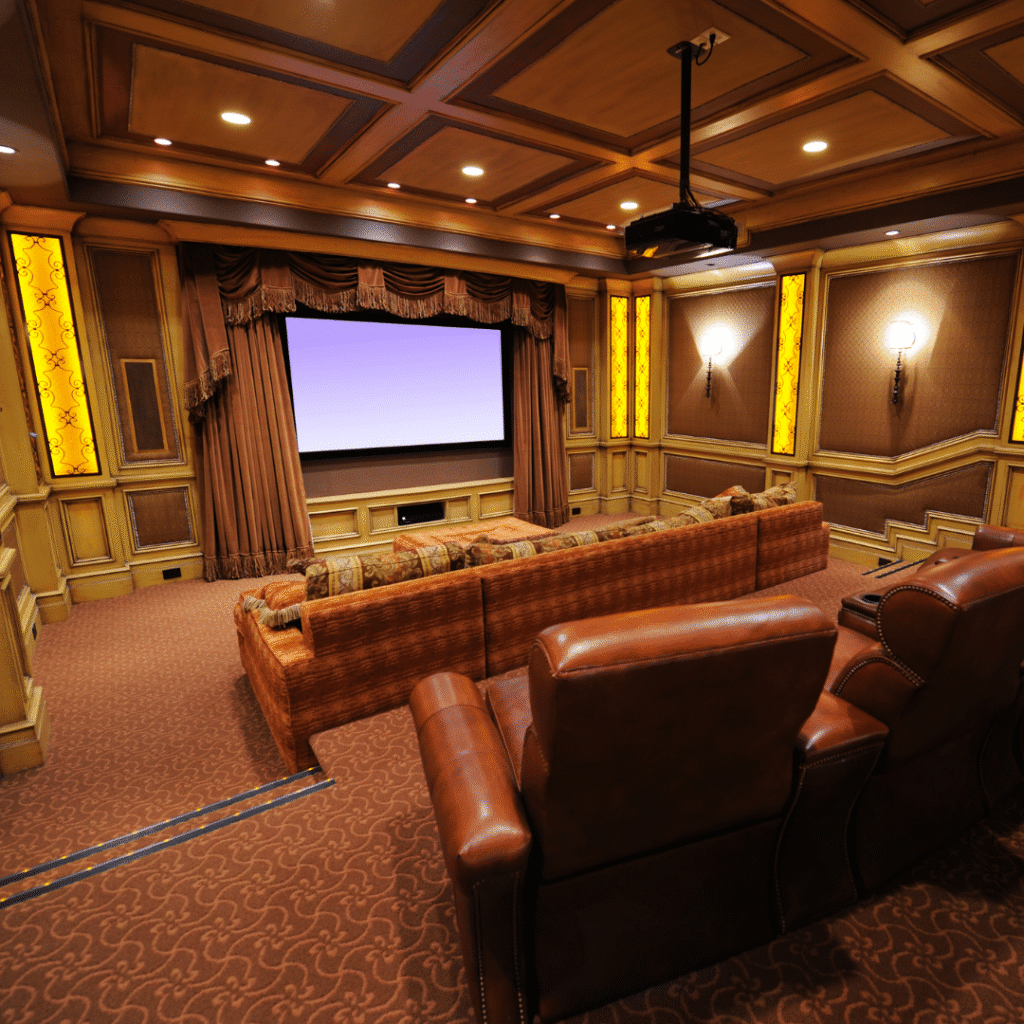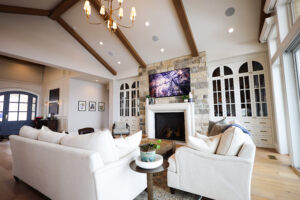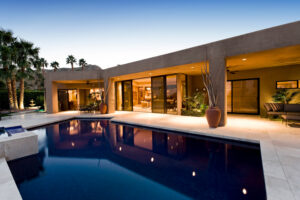Do you want to create a luxurious and relaxing home theater experience for your family and friends? If so, proper lighting is essential! In this blog post, we will discuss a variety of home theater lighting ideas that will help you create the perfect atmosphere for your space. We will cover everything from fixtures to styles, so you can find the perfect lighting look for your home theater. Let’s get started!
Home Theater Lighting
Lighting is an essential element in home theaters, just as it is for any home. It can create a certain mood and ambiance that sets the tone for your home theater experience. If you want to set up a home theater with a professional look and feel, then lighting should be one of the first things on your list! You need to get the right fixtures, position them correctly, and choose home theater lighting ideas that will make your home theater look great.
You will want a fixture that can provide ample light without being too bright or distracting from what’s on-screen. There are a variety of home theater lighting fixtures to choose from, so you can find the perfect one for your needs.
Types of Home Theater Lighting
There are a few main types of home theater lighting. Each type of home theater lighting has a different function and should be used accordingly. More importantly, each type of lighting has a different effect on the overall feeling of your home theater. Let’s take a closer look at each type of lighting and see how it can be used in home theaters.
1. Ambient Lighting
Ambient home theater lighting is the main source of light in your home that creates an overall glow for the space. It creates a comfortable and relaxing atmosphere in your home theater, while also providing enough illumination so people can safely navigate around the space without bumping into furniture or tripping on cables.
Other benefits include:
- It can help to hide any imperfections in the walls or ceiling
- Creates a cozy and inviting atmosphere for friends and family
- It helps set the mood for watching movies or TV shows
If you’re looking to add ambiance to your space, there are a few ways to do so:
- Recessed lights or ceiling fans with integrated LED bulbs are a great way to add an ambiance to your home theater.
- Place accent lamps on end tables or floor lamps near seating areas to provide additional ambient light.
- Use dimmer switches to control the amount of light in your home theater. This will allow you to adjust the light level to match the mood of the movie or TV show you’re watching.
Ambient lighting is perfect for those who want to create a comfy and relaxing home theater experience for their friends and family.
2. Task Lighting
Task home theater lighting is used for specific tasks such as reading a book. It should be bright enough to provide adequate illumination for whatever task you are doing, but not so much that it creates glare on the screen or distracts from what’s happening on-screen.
Task home theater lighting can come from:
- Recessed spotlights or pendant lights that are adjustable in direction and brightness.
- It can also be provided with floor lamps with integrated LED bulbs near seating areas where people will sit down to read a book or watch TV.
When it comes to task lighting, less is more. You don’t want too much light shining in your face or creating glare on the screen. Choose a fixture that can be directed towards the task at hand and adjust it accordingly depending on what you’re doing.
3. Accent Lighting
Accent home theater lighting is used to highlight specific features in your home theater, such as artwork or furniture. It creates focal points in your home theater and draws attention to the things you want people to see. It should never be used as the main source of light in a room. There are many ways to add accent home theater lighting to your space such as:
- Using LED strip lights or rope lights to create a border around the screen or to accentuate artwork or furniture.
- Hanging pendants or chandeliers over seating areas or in entryways.
- Adding sconces next to paintings or mirrors.
- Using table lamps with interesting shapes or designs.
Accent home theater lighting is perfect for adding flair and personality to your home theater. It can be used to highlight the things you’re most proud of or to create a unique look and feel for your space.
4. LED Lighting
LED is a popular choice for home theaters because it is energy-efficient and provides bright, consistent light. Many LED lights come in a variety of colors, so you can choose the right one to match your home theater’s décor.
Other benefits include:
- LED home theater lights last longer than other types of home theater lighting, so you won’t have to replace them as often.
- Does not produce heat or UV emissions, so it is safe to use in any room of your home.
- LED lights use low voltage, so they are safe to use around children and pets.
When it comes to home theater lighting, LED strip lights are versatile and can be installed in a variety of ways to create an accent of light such as:
- Under cabinets
- Behind crown molding
- Around the edges of a room to create a frame-like effect
However your movie room is set up, LED lighting can be used to light it up and set the mood.

5. Backlighting or Bias Lighting
Backlighting, also known as bias lighting, is a type of home theater lighting that reduces eye fatigue and improves the viewing experience. It is typically installed behind the TV and illuminates the wall or space behind it.
Backlighting is a popular home theater lighting choice because it:
- Reduces eye fatigue
- Improves the viewing experience
- Is an affordable option
- Can be installed behind any type of TV
If you’re looking for a way to improve your home theater experience, consider installing backlighting. You can do so by:
- Adding LED strip lights or rope lights to the back of your TV.
- Running the light strips up the wall and around the room to create a border effect.
- Installing a light bar on top of your TV.
There are many ways to add backlighting to your home theater, so choose what works best for you.
6. Fiber Optic Lighting
This unique type of home theater light uses thin strands of fiber optic cable to transmit light. This type of home theater lighting is popular because it creates a dramatic effect and can be used to create different moods in a space.
There are two types of fiber optic home theater lighting:
- Star ceiling: this home theater lighting system uses fiber optic cable to create a starry effect on the ceiling.
- Color-changing home theater lights: this home theater lighting system uses color-changing LEDs that are connected via fiber optic cable and can be controlled remotely or with an app on your smartphone.
Fiber optic home theater lighting is ideal for people who want to create a dramatic and unique look in their home theater. You can add fiber optic lighting to your movie room in many ways including:
- Installing a star ceiling
- Adding fiber optic light strands to the edge of your ceiling or around the edges of your room
- Running the fiber optic lights up the walls and around the room to create a border effect
While you may choose to incorporate any of these types of home theater lighting, it is important to use them in the correct way for the best results.
Home Theater Lighting Fixtures & Styles
When it comes to home theater lighting, there are many different fixtures and styles to choose from. Here are some of the most popular home theater light fixtures and how they can be used in your space:
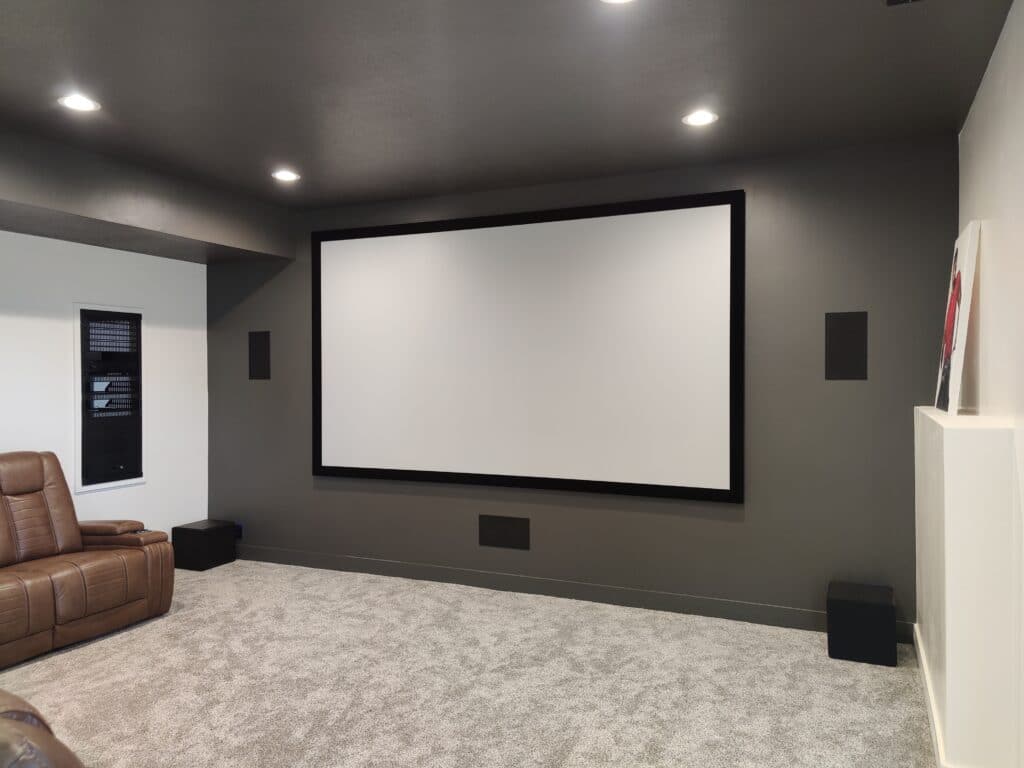
1. Recessed Lighting
Recessed lighting is a type of home theater light fixture that is installed in the ceiling or wall. This type of lighting is popular because it provides even bright light and can be used to highlight different features in a room.
There are two types of recessed home theater lighting:
- Downlights: downlights are installed in the ceiling and provide bright, focused light.
- Can lights: can lights are installed in the wall or ceiling and provide a wider area of light.
Both types of recessed home theater lights are popular because they are unobtrusive and can be used to light up a space in a variety of ways.
2. Track Lighting
Track lighting is a concentrated light. It mounts on a railing system, so you may adjust it to suit your needs. Tracks may attach to ceilings or walls depending on your lighting demands. Beams, rafters, and joints are frequently of use since they are strong and durable under pulling forces.
Track lighting offers:
- Moveability: track lights can point in any direction, which makes them a popular choice for accent lighting.
- Versatility: there are many different types of track lighting fixtures available, so you can find the perfect one for your space.
- Energy efficiency: LED track lights are a popular choice because they use less energy than other types of track lighting.
- Space: track lighting takes up less space than other types of home theater lighting fixtures.
Adjustable track lights are a good choice for home theater lighting because they allow you to direct the light where you need it without taking up too much space. Therefore, if your movie room is small, track lighting is a good option.
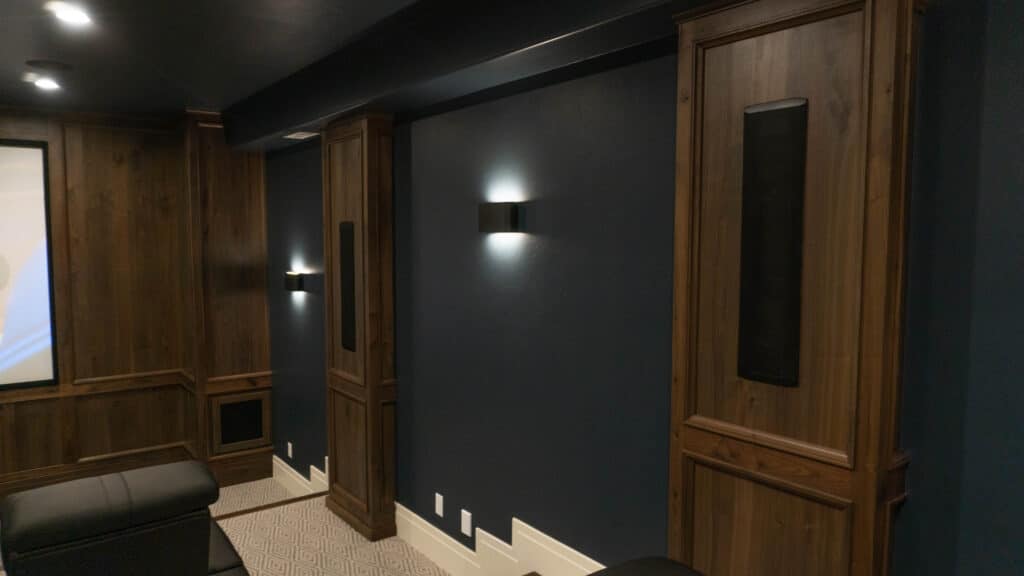
3. Wall Sconces
A sconce is a wall light fixture that relies solely on the wall for support, with no base to support the light. Although this kind of lighting is usually facing upward, it may also point downward to illuminate walkways or steps.
You can use wall sconces to light up your movie room in many ways, including:
- Installing them on either side of your screen
- Placing them at the end of your seating area
- Installing them along the wall behind your seats
- Using them to light up the walkway to your movie room
The benefits of sconce lighting include the variety available, the amount of light they provide, and the ability to create an ambiance. Whether your home cinema is in your basement, garage, or spare room, adding the perfect touch of light with sconces can make all the difference.
4. Cove Lighting
This is a type of indirect illumination, or accent lighting, incorporated into ledges, niches, or other architectural features. It also hides the fixture and provides a very uniform, pleasant glow.
Cove lighting is a popular choice for home theater lighting because it:
- Is unobtrusive: cove lights are hidden behind the architectural features they light up, so they don’t distract from the movie screen.
- Provides even illumination: it provides a uniform light that helps to create an immersive environment.
- Can highlight different features in a room.
With a sleek and unobtrusive design, cove lighting allows you to light up your home theater without taking away from the movie-going experience.
5. Pendant Lighting
A pendant light is a type of hanging light that typically consists of a metal or glass shade with a cord or chain attached. Pendants provide general lighting and are often put in place of overhead lights.
You can use pendant lighting to light up your home theater in several different ways, including:
- Hang them over your seating area
- Hanging them over the screen
- Hanging them in a group to create an interesting effect
The benefits of pendant lighting include their versatility and ability to provide general light. If you’re looking for a way to add a touch of personality to your home theater, pendant lights are a great option.
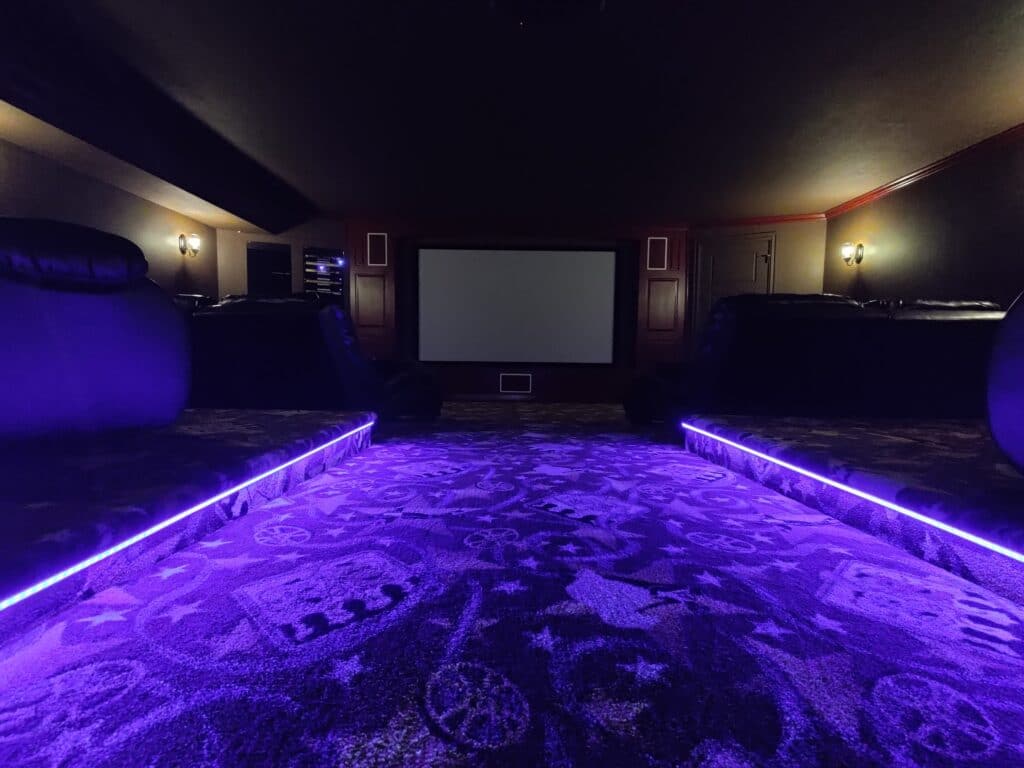
6. Strip Lighting
Strip lighting is a type of accent lighting that can light up floor walkways, walls, ceilings, or furniture. It is usually on top of a surface and consists of a series of LED lights in a flexible strip.
Strip lighting is a good choice for home theater lighting because:
- Flexible: strip lighting can fit around corners and other obstacles.
- Easy to install: strip lighting can be mounted using adhesive or screws.
- Energy efficient: LED strip lights use less energy than other types of strip lighting.
Depending on your home theater setup, strip lighting may be a good choice.
Home Theater Lighting Ideas
When it comes to home theater lighting, there are a few ideas you should keep in mind. First of all, the type of home theater lighting fixtures will depend on where they will be in place. If you have a small home theater with limited space for lighting fixtures, then using recessed lighting or wall sconces may be the best option.
If you have a larger home theater, then you may want to consider using pendant lights, cove lighting, or strip lighting. These will create an interesting and immersive environment. Whatever your choice, ensure that the lighting fixtures are set in a way that doesn’t distract from the movie screen.
Finally, keep in mind the effect you want to create. Whether you’re going for a cozy and relaxing atmosphere or an exciting and dramatic look, choose the right lighting fixtures to help achieve your goal.
Integrated Lighting Control and Automation
A lighting control and automation system is a great way to add extra flexibility to your home theater lighting. With just a few taps, you can change the mood. This allows you to create the perfect atmosphere for any occasion.
Read more: Smart Home Benefits
Motorized Shades
If you want to take your home theater lighting to the next level, consider adding motorized shades. Motorized shades can be used to control the amount of light that enters a room, allowing you to create any mood you desire.
Home theaters are a great way to bring your favorite TV shows and movies into the comfort of your home.
A well-lit space is necessary for watching those late-night movie marathons! So, be sure to take some time to think about what type of lighting you’ll need for the perfect viewing experience.
Advanced Integrated Systems offers home theater installation and home theater lighting installation to help you get the most out of your space. From surround sound to home automation, our home theater specialists can help you create the perfect environment for watching your favorite movies and TV shows. Contact us today to learn more!
Check out our Budget Calculator!
Related Articles:

